WHAT'S NEW ACROSS THE WORLD
What's
new April 2000
What's
new July 2000
What's
new October 2000
What's
new January 2001
What's
new April 2001
| What's New ©by
Laif DeMason
As of this writing, there is promising news
from several areas in the cichlid world. First, there have been some productive
collecting efforts, resulting in actual fish exports from the Congo (formally
Zaire) on the shores of western Lake Tanganyika! It is hard to believe
that it has been nearly seven years since exports of consequence have occurred
from this vast coastline. However we must wait and see, as I remember empty
promises from the past! Second, areas in West Africa such as Guinea, Cameroon,
and Congo have expanded exports and collecting areas. Third, nearly all
of the previous weather-related problems for collecting and shipping have
been curtailed. With any luck at all, cichlid fans may see a new chapter
unfold before them.
Here’s “what’s new” on the cichlid scene: |
Lake Tanganyika
Dreamed about by exporters since the 1970s, Congo may soon export fishes
again. Wild-caught specimens of several Congo favorites are expected, including
the Zairean “blue frontosa.” Other poorly-represented areas in southern
Tanzania are expected to come on line as well. Exports from Burundi and
Zambia are frequent, as are supplies of bred Tanganyika cichlids.
|
what's new: Lake Tanganyika
|
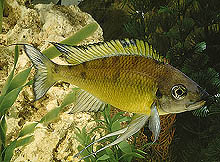
Formally collected from the Congo, Opthalmotilapia
nasuta “Bilia” may soon be available again. |
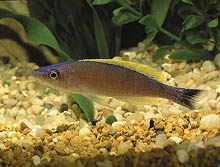
Collected in the past but re-exported from Zambia,
Cyprichromis leptosoma “new blue” has arrived. |
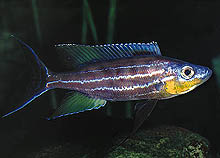
Nearly impossible to breed, fry from Benthochromis
tricoti are available from Burundi as they have solved the supply bottleneck!
An adult male is pictured here. Photo by A. Konings. |
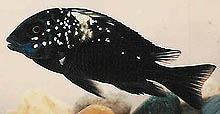
This unusual freckle-faced T. duboisi is a
farm-bred color mutation that won’t be commercially available for some
time. Good things come to those who wait! Photo courtesy of Fishes of Burundi. |
Lake Malawi
Collecting activities in Tanzanian waters of Lake Malawi have increased
of late. Weather problems have declined along the Malawi coast, favoring
broad-based collecting again. Mozambique waters remain off limits still.
As of May 2001, supplies are spotty on some of the small farmed Malawi
cichlids, a situation that the summer breeding season will soon correct.

Collected at Eccles Reef, this Pseudotropheus acei
sports yellow finnage on a purple body. Photo by A. Konings. |
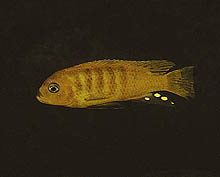
Collected near Lupingu, Tanzania, Pseudotropheus
sp. “kingsizei orange” is also sold as Ps. “solid orange.” |
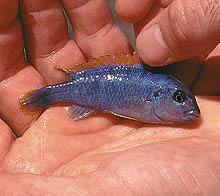
From Ndumbi, Tanzania, Ps. sp. “red top ndumbi”
shows variable red coloration in the dorsum. |
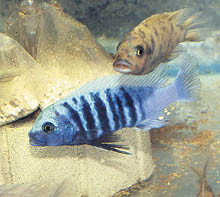
Several Metriaclima zebra types have been exported
from Tanzania; here the Manda variety with its shiny nose and forehead
is shown. |
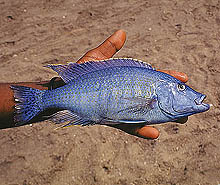
Often exported as small, drab green fishes, here is
a male Dimidiochromis kiwingi in full color. Photo by C. Kacirek. |
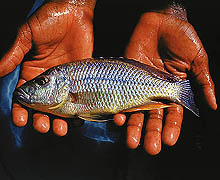
Infrequently collected by seine netting, Dimidiochromis
strigatus is often available from bred sources. Photo by C. Kacirek. |
Victoria
No news to report from the Victorian basin. Promises of exports of wild-caught
material have not been fulfilled. Breeders have reported some unusual “sports”
which may materialize on the market soon.
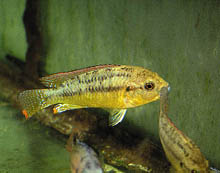
Although plentiful in Uganda, Pseudocrenilabrus
multicolor “yellow” still can be bought from specialty breeders. |
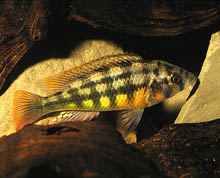 Also still present in collectable number in Lake Victoria is ‘Haplochromis’
sp. “rock kribensis.” Photo by M. Smith.
Also still present in collectable number in Lake Victoria is ‘Haplochromis’
sp. “rock kribensis.” Photo by M. Smith. |
West Africa
There has been increased activity of late from several exporting countries
as the rainy season begins. Guinea, Cameroon, Nigeria, and Congo have been
active.
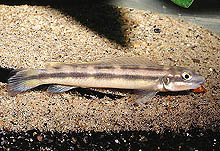
Arriving in fair numbers from Guinea, Gobiocichla
wonderi is an oddity for those who specialize. Photo by O. Lucanus. |

Also from Guinea, this barred cichlid is sold as Pelvicachromis
humilis “striped”. |
Neotropics
The collecting season has begun in earnest in many areas of South America.
Fortunately, some new exporters are now going after specialty fishes, as
well as cichlids from isolated sources. This trend could produce larger
numbers of rarely seen items — good news for dwarf cichlid, discus, and
pike cichlid buffs.
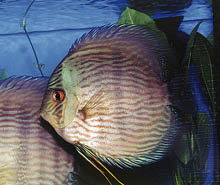
From Brazil, a wild-caught blue-front Symphysodon
discus of the Heckel variety. |
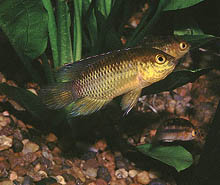
Exported from Guyana, the golden-colored Nannacara
anomala is an attractive dwarf cichlid. |
|